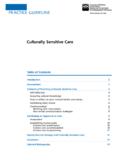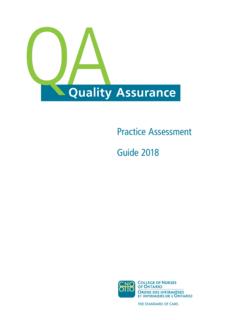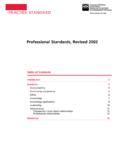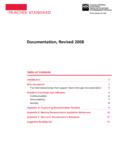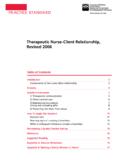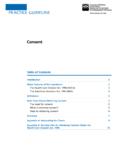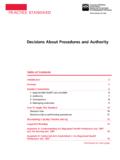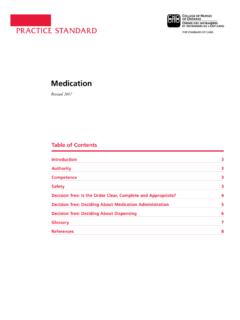Transcription of Guidance in Medical Assistance in Dying - CNO
1 Guidanceon Nurses Roles in Medical Assistance in Dying April 2021 College of Nurses of OntarioGuidance on Nurses Roles in Medical Assistance in DyingTable of Contents Introduction 3 Key legislative changes 5 Providing Medical Assistance in Dying 5 General nursing accountabilities 5 Conscientious objection 6 A Nurse Practitioner s role in Medical Assistance in Dying 6 Stages in Medical Assistance in Dying 7 Stage 1: Determine eligibility 7 When a patient s natural death is reasonably foreseeable Stage 2: Ensure safeguards are met 8 Stage 3: Consent 10 When a patient s natural death is NOT reasonably foreseeable Stage 2: Ensure safeguards are met 12 Stage 3: Consent 13 Stage 4: Provide Medical Assistance in Dying 13 Prescribing, providing or administering medications that cause death 13 Reporting requirements 14 Other considerations 15 Glossary 16 Resources 17 Acknowledgement 18 2 Introduction This document provides nurses1 with Guidance about their accountabilities related to Medical Assistance in Nurses are also accountable for complying with other College of Nurses of Ontario (CNO) standards and guidelines as applicable.
2 They are available at If you have questions or concerns about how the legislation applies to your practice or about liabilities, please talk to your organization or seek legal advice. Medical Assistance in Dying (MAID), as defined in the Criminal Code, refers to when: A Nurse Practitioner (NP) or physician provides Assistance by administering a medicationto a patient, at their request, that causes their death ( practitioner-assisted Medical Assistance in Dying ) or An NP or physician prescribes or provides a medication to a patient, at their request,so that they may self-administer the medication, and in doing so, cause their own death ( patient self-administered Medical Assistance in Dying ). Key legislative changes The Criminal Code provisions that relate to Medical Assistance in Dying first came into effect on June 17, 2016 through Bill C-14. The Bill allowed eligible people to receive Medical Assistance in Dying .
3 It establishes safeguards for patients and offers protection to health professionals who provide Medical Assistance in Dying , along with people who assist in the process in keeping with the law. Medical Assistance in Dying must be provided with reasonable knowledge, care and skill, and in accordance with any applicable laws, rules or standards. Nurses who fail to comply with legal requirements may be convicted of a criminal offence. Truchon V Canada (AG) decision On Sept. 11, 2019, the superior court of Qu bec, in its Truchon v Canada (AG) decision, declared that it is unconstitutional for the federal Medical Assistance in Dying legislation to require that natural death must be reasonably foreseeable to be eligible for Medical Assistance in Dying . Also, the end of life eligibility criterion contained in Quebec s Act Respecting End-of-Life Care was declared unconstitutional. 1 RNs, RPNs and NPs 2 This document is based on An Act to amend the Criminal Code and to make related amendments to other Acts ( Medical Assistance in Dying ): #docCont.
4 3 College of Nurses of OntarioGuidance on Nurses Roles in Medical Assistance in Dying -Bill C-7 Bill C-7, which took effect Mar. 17, 2021 is the Government of Canada s legislative response to the Tr u c h o n decision. Bill C-7 made the following amendments to the Criminal Code: Eligibility criteriaRemoved the reasonably foreseeable natural death criterion and excluded cases where mental illness is the sole underlying Medical condition. This exclusion remains in effect until Mar. 17, 2023. The government will review this criterion with an expert panel. SafeguardsCreated a two-track approach to procedural safeguards for practitioners to follow one set of eased safeguards for people whose natural death is reasonably foreseeable, and a second set of new and clarified safeguards for people whose natural death is not reasonably foreseeable. Medical Assistance in dyingBill C-7 Natural death reasonably foreseeable Natural death NOT reasonably foreseeable Advanced consentPermitted the administration of Medical Assistance in Dying on the basis of advancedconsent.
5 In other words, the requirement for final consent at the time of the medicalassistance in Dying procedure would be waived by operation of law: for patients whose natural death is reasonably foreseeable and who have been assessedand approved for Medical Assistance in Dying , if they lose capacity to consent beforetheir preferred date for Medical Assistance in Dying and have a written arrangementwith a practitioner3 to permit advanced consent to the administration of Medical Assistance in Dying by a practitioner in cases of failed self-administration Monitoring regimeEnhanced the reporting requirements based on experiences with the federal Medical Assistance in Dying monitoring regime to date. 3 In this document, practitioner refers to an NP or physician. 4 College of Nurses of OntarioGuidance on Nurses Roles in Medical Assistance in Dying Providing Medical Assistance in Dying General nursing accountabilities Medical Assistance in Dying requires the involvement of an NP or a physician.
6 An NP can provide an eligible patient with Medical Assistance in Dying provided it is done in accordance with the federal law, as well as any applicable provincial laws, rules or standards. Registered Nurses (RNs) and Registered Practical Nurses (RPNs) can participate by providing nursing care and supporting an NP or physician who is providing Medical Assistance in Dying , according to the law. NP students can participate in providing nursing care in current capacity as an RN but they cannot perform eligibility assessments for Medical Assistance in Dying . Only physicians and NPs have this authority. NP students can, however, learn about the eligibility assessment process through observation and discussion with their mentors. When a patient chooses practitioner-assisted Medical Assistance in Dying , the law allows only NPs and physicians to administer medications to cause the death of the patient.
7 No other health care providers, including RNs and RPNs, are legally permitted to administer medication for Medical Assistance in Dying . When any nurse is assisting an NP or a physician with providing Medical Assistance in Dying in accordance with the law, they may perform activities such as (but not limited to): educating patients, providing support and comfort to patients and family inserting an intravenous line (with an order) that will be used to administer medicationsthat will cause the death of a patient acting as an independent witnessNurses who give information to patients about the lawful provision of Medical Assistance in Dying must ensure they do not encourage or pressure the patient to choose Medical Assistance in Dying . 5 College of Nurses of OntarioGuidance on Nurses Roles in Medical Assistance in Dying Conscientious objection CNO recognizes a nurse s freedom of conscience.
8 A nurse may have beliefs and values that differ from those of a patient and may not be comfortable providing or participating in Medical Assistance in Dying . The law does not compel an individual to provide or assist in providing Medical Assistance in Dying . Therefore, a nurse may conscientiously object. However, conscientious objection must not be directly conveyed to the patient and no moral judgments about the beliefs, lifestyle, identity or characteristics of the patient should be expressed. Nurses who conscientiously object must transfer the care of the patient to another nurse or health care provider who will address the patient s needs. Nurses can work with their employers to identify an appropriate alternative care provider. Until a replacement caregiver is found, the nurse must continue to provide other nursing care, as per the patient s care plan that is not related to activities associated with Medical Assistance in Dying .
9 Practitioners who conscientiously object to providing Medical Assistance in Dying can either make a referral using their own professional networks or institutional policies, or they may contact the Ministry of Health and Long-Term Care s Care Coordination Service. A Nurse Practitioner s role in Medical Assistance in Dying The law allows NPs to provide the following to patients who have requested Medical Assistance in Dying : administering a medication to the patient, at their request, that will cause the patient s death ( , practitioner-assisted Medical Assistance in Dying ) and prescribing or providing a medication to the patient to self-administer, and in doing so,cause their own death ( , patient self-administered Medical Assistance in Dying ). NPs have reporting requirements that occur at various stages during the process of Medical Assistance in Dying . The most obvious is the report to the Office of the Chief Coroner at the end of Medical Assistance in Dying .
10 However, NPs are also required to report to Health Canada under certain conditions (See the Reporting Requirements section on page 14) In addition, an NP may provide an independent second opinion on a patient s eligibility to receive Medical Assistance in Dying . NPs should consider their ability to provide these services early in the process to support timely access to care. NPs who do not provide Medical Assistance in Dying must refer the patient who requests this to another NP or physician who provides this service. 6 College of Nurses of OntarioGuidance on Nurses Roles in Medical Assistance in Dying Stages in Medical Assistance in Dying The following stages are involved whether a patient s natural death is reasonably foreseeable or not: Stage 1: Determine eligibility Stage 2: Ensure safeguards are met Stage 3: Obtain consent Stage 4: Provide Medical Assistance in Dying either by the NP or physician, or self-administered by the patient NPs who may be providing Medical Assistance in Dying (and RNs and RPNs who may be supporting this process) must have a comprehensive understanding of these stages, including the risks, eligibility criteria, safeguards, and processes.
